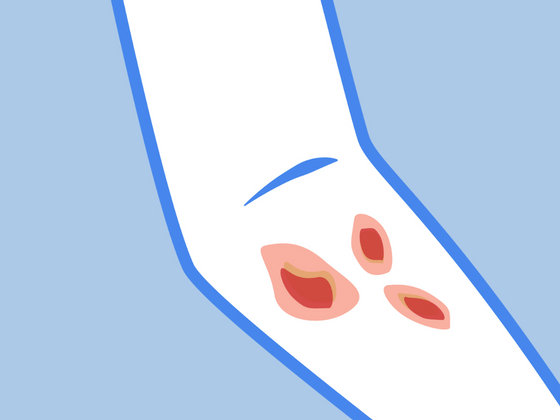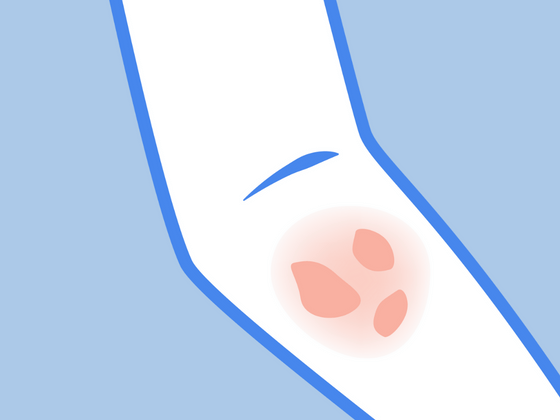One of the most concerning complications associated with the smallpox vaccine is Eczema Vaccinatum (EV), a severe and potentially life-threatening condition. While the smallpox vaccine is free of the smallpox virus, ensuring it cannot transmit smallpox to individuals who receive it, it can carry rare but serious risks for people with pre-existing conditions such as atopic dermatitis or eczema.
These days, the vaccination is exclusively administered to specific military and Department of Defense personnel and individuals workingirritated skin in biological laboratories. However, although eczema vaccinatum is rare, recognizing its symptoms still remains crucial, as immediate treatment is paramount for effective management.
In this blog post, we're exploring eczema vaccinatum in detail, including:
-
The symptoms of eczema vaccinatum
-
What causes eczema vaccinatum
-
How you can treat uncomfortable symptoms naturally
Read on to learn more about eczema vaccinatum - and how you can find the relief you deserve.
What is Eczema Vaccinatum?
Eczema Vaccinatum (EV) is a rare and serious complication that can arise after receiving the smallpox vaccine. It occurs when the live vaccinia virus in the smallpox vaccine spreads and causes systemic infection in individuals with pre-existing atopic dermatitis (eczema) or other conditions that compromise the skin's integrity. Symptoms include a painful rash, fever, and more, posing the most significant risk to young children. As severe cases can be fatal, prompt medical care is crucial.
What Does Eczema Vaccinatum Look Like?
Eczema Vaccinatum (EV) presents specific symptoms that differentiate it from a standard reaction to the smallpox vaccine. Severe eczema vaccinatum symptoms require immediate medical attention. The signs and symptoms of EV include open skin sores, high fever, body aches, pale or clammy skin, and a pervasive sense of unwellness.
Below, we describe the signs and symptoms in more detail:
Extensive Rash:
Beyond the typical vaccination site, there's the development of a widespread and often severe rash. Unlike a typical rash, this rash can appear as numerous lesions or bumps on the skin, extending beyond the immediate area of the vaccination site.
Progressive Rash:
The rash worsens progressively, spreading rapidly and affecting larger body areas. It can be particularly aggressive and extensive in individuals with compromised skin barriers like eczema.
Systemic Symptoms:
Along with the skin manifestations, individuals might experience systemic symptoms such as fever, malaise, and general discomfort. In severe cases, there might be indications of systemic illness, including signs of septic shock or a rapid decline in overall health.
Potential Complications and Severity in Atopic Dermatitis Areas
EV can lead to complications due to the systemic spread of the virus, which may include increased fever, enlarged lymph nodes, and, in severe cases, organ dysfunction or failure. Additionally, in individuals with active eczema, the rash caused by EV might be particularly severe in areas affected by eczema, leading to increased inflammation, itching, and discomfort compared to unaffected skin areas.
Due to these complications, it's crucial to promptly differentiate EV from other skin conditions or adverse reactions to vaccinations. Due to the severity of symptoms and potential complications associated with EV, immediate medical attention and intervention are necessary if there is suspicion or confirmation of this rare complication following smallpox vaccination.
Why Are People with Eczema Affected?
The skin's natural defenses are compromised because eczema is associated with a defective skin barrier function. This elevates the vulnerability to bacterial, fungal, and viral skin infections in individuals with this condition. Such infections may present unique challenges, necessitating additional or specialized treatments. Moreover, individuals with eczema risk infection if the live virus from the smallpox vaccine comes into contact with their skin. This scenario may unfold if a person with eczema:
-
Makes contact with the site of their smallpox vaccination before it has completely healed
-
Handles the bandage that covers their vaccination site
-
Touches objects that have been in contact with an unhealed vaccination site, such as clothing, towels, or washcloths
-
Scratches the vaccination site
-
Touches the vaccination site, vaccination bandage, or personal items like clothing, towels, or washcloths belonging to another person.
At times, individuals with eczema may unknowingly transmit the smallpox vaccine virus. For example, they might remove the bandage, thinking the site has healed, and then apply their regular nightly lotion or corticosteroid cream. If the vaccination site isn't entirely healed, applying lotion may inadvertently spread the virus, aiding its penetration into the skin.
Diagnosis and Treatment Options
Diagnosing EV is typically straightforward for doctors through a single examination due to the distinctiveness of the skin lesions.
It's important to note that EV exclusively affects individuals with eczema who have been in contact with the smallpox vaccine, a rarity in modern times. This rarity allows for a prompt confirmation or exclusion of EV.
The Centers for Disease Control and Prevention (CDC) and the United States Food and Drug Administration (FDA) have approved and currently endorse vaccinia immune globulin (VIG) as the recommended treatment for EV. Administered via injection over several days, early initiation of treatment enhances its effectiveness. Occasionally, additional measures such as antibiotics may be prescribed to prevent or treat bacterial infections or open lesions.
What factors increase the risk of eczema vaccinatum?
While extremely rare, the primary risk factor is having eczema and receiving the smallpox vaccine. That's why the smallpox vaccination isn't recommended for individuals with eczema or those sharing households with eczema sufferers. This precaution extends to individuals who haven't experienced recent eczema flare-ups. For example, adults without current eczema but with a history of childhood eczema are ineligible for the smallpox vaccine.
It's crucial to recognize that individuals with certain chronic skin conditions, such as Darier’s disease, are also unsuitable candidates for the smallpox vaccine.
If you have a chronic skin condition or someone in your household requires a smallpox vaccine for any reason, consult with a healthcare professional. There are alternative smallpox vaccines tailored for individuals with immune conditions such as eczema and HIV.
Managing Symptoms at Home
Managing the symptoms of Eczema Vaccinatum involves a comprehensive approach aimed at alleviating the skin manifestations, controlling systemic symptoms, and preventing potential complications. Using gentle eczema cream can be an important part of symptom management. While seeking immediate medical attention from health care workers is crucial, here are some ways you can alleviate painful symptoms at home:
Keep the Skin Moisturized
Keeping the skin hydrated can help reduce uncomfortable symptoms and help you find relief. Give this Organic Manuka Skin Soothing Cream a try and benefit from its natural healing powers.
Use Mild Soaps
To prevent further skin irritation, choose mild, fragrance-free eczema soap like this 20% Pine Tar Soap with Tallow. Valued for its strong antibacterial and anti-inflammatory properties, pine tar has been a traditional remedy for wound healing, making it an excellent choice for soothing irritated skin. Similarly, beef tallow cream offers natural healing benefits for compromised skin.
Apply a Cold Compress
Applying a cool compress to the affected areas can help relieve itching, inflammation, as well as the urge to scratch.
Wear Comfortable Clothing
Wearing breathable fabrics for eczema ensures comfort, reduces irritation, and promotes airflow, supporting skin health and minimizing flare-ups. Check out the Remedywear™ (TENCEL + Zinc) Long Sleeve Shirt for Adults and Kids for relief on the back, chest, and arms.
Treat your Skin Today
For individuals with eczema, understanding Eczema Vaccinatum is crucial. Be sure to take the necessary steps to ensure your safety and the safety of others in case of contact with the smallpox vaccine.








